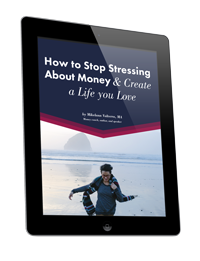 A couple of Saturdays ago, I finally sat down with my magic crystal ball. I was ready to create my personal 2020 spending plan. I was a bit nervous this year about what I would see in the ball. I am finishing a large construction project on my house, and my son is in his third year of college. (Wow.) And I’ve become very involved in the Seattle Tango community, so of course I want to take lots of classes and go on tango trips. Who doesn’t want to dance and travel! But the cost. Yikes…
A couple of Saturdays ago, I finally sat down with my magic crystal ball. I was ready to create my personal 2020 spending plan. I was a bit nervous this year about what I would see in the ball. I am finishing a large construction project on my house, and my son is in his third year of college. (Wow.) And I’ve become very involved in the Seattle Tango community, so of course I want to take lots of classes and go on tango trips. Who doesn’t want to dance and travel! But the cost. Yikes…
So I sat down with a cup of coffee, called up The Crystal Ball and set to work.
(Lights darken, crystal ball begins to glow, getting brighter and brighter, mists swirl in its depth and begin to part, and I lean forward, peering into the future….)
Two hours later, I had all my answers. Well, I had a lot of answers and I wanted time to think. To feel. To journal. To digest the future I had just seen. This future seemed to have several scenarios and I was going to have to make some choices. I am reminded of that saying, “You can have anything you want, but you can’t have everything you want.” Rats.
So I poured another cup of coffee. And found some chocolate.
Each year I go through this ritual. I simply can’t imagine living without a crystal ball—my annual spending plan. Some call it a “budget”, but I really hate that word and I don’t even let my money coaching clients use it. It’s a PLAN. My plan. (The tool I love the most for creating a plan is www.moneygrit.com) I also create a plan every month to guide me through the month. And honestly it’s hard for me to imagine not having this monthly guiding light to keep my stress down. But every January I take it to the next level and plan the entire year. I do for myself what I help my clients do.
I think about all the things I really want in the coming year, and all of the things I need. (Like travel and new blinds and furniture for the addition.) I think about the reality of my life and what large expenses may occur regardless of my love of them—car repair, dental work…. I think about my goals and my dreams for the future.
Of course I also put all my normal monthly expenses into my annual plan, but I debate those too. Every year I look at my expense with a fresh eye. Is it time to change cable companies? Am I happy with my hairdresser? (Yes!) Is it time to let go of the hardcopy Sunday newspaper? (Maybe.)
When I work on my annual spending plan, I have to balance all of my expenses against the money I have coming in this year. Oh- that part. But there is a fundamental truth to money that doesn’t change: you simply cannot spend more money than you have coming in. Well, you can by using debt or draining your assets, but in the long run, there is great unhappiness and stress down that road.
It’s certainly true that money is not the most important thing. But I find that when people have a clear plan and have a way to actually follow their plan, they think less about money and can settle down and focus on what is important in their life. I have definitely found this to be the case in my own life.
For now, I’m still working on my own annual plan. The beauty of the crystal ball is that it merely shows possible futures and outcomes. It shows me where I will be financially come next December if I do various things. Nothing is set in stone. I get to ultimately decide which path I will go down. Then I can relax and put some time into my hobbies, my family, my friends, my life.
I love the feeling of being in the driver’s seat of my own life!
P.S. The software I use with my clients to help them create an annual plan is here- www.moneygrit.com. It is spending plan software designed to help you step out of the “money fog” and start planning the life you want.


 Thanksgiving is coming up. I hope you all have restful plans for it. After turkey, I personally plan on dancing tango the rest of the holiday weekend. Fun!
Thanksgiving is coming up. I hope you all have restful plans for it. After turkey, I personally plan on dancing tango the rest of the holiday weekend. Fun!
 I work with clients on how to tame financial anxiety. I teach them the practical skills needed to manage their cash flow as well as help them explore their emotions around money. This work propels them into a balanced lifestyle- where they spend within their means and feel good about it.
I work with clients on how to tame financial anxiety. I teach them the practical skills needed to manage their cash flow as well as help them explore their emotions around money. This work propels them into a balanced lifestyle- where they spend within their means and feel good about it.
 A common question I get is “what is the difference between a financial planner and a money coach?”
A common question I get is “what is the difference between a financial planner and a money coach?”


 Want some joyful inspiration for your money life? Here is an amazing podcast interview I did on how to live your financial life in alignment with your core values- so you can spend on what truly gives you JOY, while also protecting your future. This interview also looks at how to unhook your self-worth from your net worth. And then it addresses the metaphysical question of money as energy and how to feel truly abundant. Give a listen- I think you’ll be truly inspired.
Want some joyful inspiration for your money life? Here is an amazing podcast interview I did on how to live your financial life in alignment with your core values- so you can spend on what truly gives you JOY, while also protecting your future. This interview also looks at how to unhook your self-worth from your net worth. And then it addresses the metaphysical question of money as energy and how to feel truly abundant. Give a listen- I think you’ll be truly inspired.
 If you want to avoid that January spending hangover and December stress, find 15 minutes, a pad of paper and a cup of tea.
If you want to avoid that January spending hangover and December stress, find 15 minutes, a pad of paper and a cup of tea.
 saving $100 a month into a 529 plan. That’s it. Fast forward to today and we have his tuition, housing, and meal plan fully funded for over the next two years at Western Washington University ($39,000). To this we added a $5,000 GET account from his grandmother. He will have scholarship money that is the equivalent of one year’s costs. We are cash flowing the rest. Starting last month, we stopped funding the 529 and now my ex-husband and I each put $225 into a dedicated savings account. Each month. We estimate this will cover our son’s fourth year. Every family is different. I simply share it to give you one way to think about college funding.
saving $100 a month into a 529 plan. That’s it. Fast forward to today and we have his tuition, housing, and meal plan fully funded for over the next two years at Western Washington University ($39,000). To this we added a $5,000 GET account from his grandmother. He will have scholarship money that is the equivalent of one year’s costs. We are cash flowing the rest. Starting last month, we stopped funding the 529 and now my ex-husband and I each put $225 into a dedicated savings account. Each month. We estimate this will cover our son’s fourth year. Every family is different. I simply share it to give you one way to think about college funding.


 Want to know a secret to feeling more peaceful and in control with your money? Simplify your finances. And the best way to do this is to limit the number of accounts you have. Simpler is better.
Want to know a secret to feeling more peaceful and in control with your money? Simplify your finances. And the best way to do this is to limit the number of accounts you have. Simpler is better.